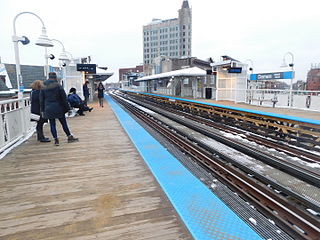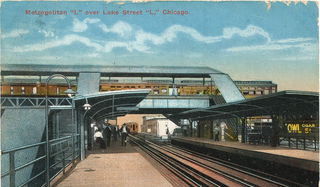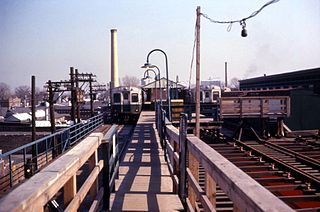
The Chicago "L" is the rapid transit system serving the city of Chicago and some of its surrounding suburbs in the U.S. state of Illinois. Operated by the Chicago Transit Authority (CTA), it is the fourth-largest rapid transit system in the United States in terms of total route length, at 102.8 miles (165.4 km) long as of 2014, and the third-busiest rapid transit system in the United States. In 2016, the "L" had 1,492 rail cars, eight different routes, and 145 train stations. In 2023, the system had 117,447,000 rides, or about 373,800 per weekday in the fourth quarter of 2023.

Ashland is an 'L' station on the CTA's Green and Pink Lines. It is an elevated station with two side platforms, located in Chicago's Near West Side neighborhood at 1601 West Lake Street. Just to the west of the station, the Pink Line branches off from the Lake Street branch to follow the Paulina Connector to the Douglas branch. The adjacent stations are California (Green), which is located about 1+1⁄2 miles (2.4 km) to the west, Polk (Pink), which is located about 1 mile (1.6 km) to the south, and Morgan station, approximately 3⁄4 mile (1.2 km) to the east.

Western is an elevated rapid transit station on the Chicago "L"'s Blue Line, where it is located on the O'Hare branch. The station, opened in 1895, is located within the Bucktown neighborhood in the larger Logan Square community area. It has two side platforms at track level with a station house at street level.

Damen is a rapid transit station on the Chicago "L", currently serving the O'Hare branch of its Blue Line. Opened on May 6, 1895, as Robey, it is the oldest station on the Blue Line. The station serves the popular Bucktown and Wicker Park neighborhoods, and is consistently in the top 40 highest-ridership "L" stations. It has two wooden side platforms and a brick station house at street level. The west platform, serving southbound trains, contains a tower that has never been used but is a relic of the station's past. The station is served by three bus routes on Damen, Milwaukee, and North Avenues, which are each descended from streetcar lines on those streets in the early 20th century. The Blue Line has owl service; while the surrounding streetcar lines also had owl service in the early 20th century, the modern bus services do not.

Morgan is a rapid transit station on the Chicago "L"'s Green and Pink Lines in Chicago's Near West Side neighborhood. The current station opened at this location in 2012, where a previous station stood from 1893 to 1949.

The Logan Square branch was an elevated rapid transit line of the Chicago "L", where it was one of the branches of the Metropolitan West Side Elevated Railroad. Diverging north from the Metropolitan's main line west of Marshfield station, it opened in 1895 and served Chicago's Logan Square and West Town neighborhoods. North of Damen station, the Humboldt Park branch diverged from the Logan Square branch, going west to serve Humboldt Park. The original Logan Square branch was separated into several sections in 1951, some of which remain in revenue service as of 2023.

Damen is an under construction rapid transit station on the Chicago "L"'s Green Line, that is expected to open in mid-2024. A station existed at this location from 1893 to 1948; opened as Robey in 1893, it was one of the original stations on what was then known as the Lake Street Elevated. The removal of the old station created a 1.5-mile (2.4 km) gap between the remaining stations. As the surrounding neighborhood saw an increase in new developments, the need for a replacement station grew. The station will also provide closer access to the United Center sports arena.

The Lake Street Transfer station was a rapid transit station on the Chicago "L", serving as a transfer station between its Lake Street Elevated Railroad and the Logan Square branch of its Metropolitan West Side Elevated Railroad. Located where the Logan Square branch crossed over the Lake Street Elevated, it was in service from 1913 to 1951, when it was rendered obsolete by the opening of the Dearborn Street subway.

Marshfield was a rapid transit station on the Chicago "L" in service between 1895 and 1954. Constructed by the Metropolitan West Side Elevated Railroad, it was the westernmost station of the Metropolitan's main line, which then diverged into three branches. Marshfield was also served by the Aurora Elgin and Chicago Railway (AE&C) and its descendant the Chicago Aurora and Elgin Railroad (CA&E), an interurban, between 1905 and 1953.

Madison was a rapid transit station on the Chicago "L"'s Metropolitan West Side Elevated Railroad, serving its Logan Square branch from 1895 to 1951. The station was typical of those constructed by the Metropolitan, with a Queen Anne station house and two wooden side platforms adjacent to the tracks. For much of its existence, Madison served the nearby sports arena Chicago Stadium.

Laflin was a rapid transit station operated by the Chicago "L"'s Metropolitan West Side Elevated Railroad and located on its main line. The station existed from 1895 to 1951, when it was closed due to low ridership. The entire main line would soon be demolished for construction of the Eisenhower Expressway and its Congress Line, and the niche served by the Laflin would be filled by an entrance on the new line's Racine station.
Canal was a rapid transit station located on the Metropolitan main line of the Chicago "L" that was in service from 1895 to 1958, when the entire main line was replaced by the Congress Line located in the median of the nearby Eisenhower Expressway. Starting in 1927, the interurban Chicago Aurora and Elgin Railroad (CA&E) also served the station, continuing until 1953. The station connected with Chicago's Union Station, which was one of the city's rail terminals. One of the busiest stations on the Metropolitan's routes, and of the "L" in general, it opened a second entrance on Clinton Street in 1914.
Division was a rapid transit station on the Chicago "L"'s Logan Square branch, one of several branches of the Metropolitan West Side Elevated Railroad. Located on Division Street, the station was constructed by the Metropolitan in the early 1890s and began service on May 6, 1895.
Chicago was a rapid transit station on the Logan Square branch of the Chicago "L", one of the several branches of the Metropolitan West Side Elevated Railroad, between 1895 and 1951. Located on Chicago Avenue, the station was constructed by the Metropolitan in the early 1890s and began service on May 6, 1895.
Grand was a rapid transit station on the Chicago "L"'s Logan Square branch, one of the several branches of the Metropolitan West Side Elevated Railroad. Located on Grand Avenue, the station was constructed by the Metropolitan in the early 1890s and began service on May 6, 1895.

Loomis was a rapid transit station on the Chicago Transit Authority Lake Street Elevated, which is now part of the Green Line. The station was located at the intersection of Lake Street, Loomis Street, and Ogden Avenue in the Near West Side neighborhood. Loomis opened on November 6, 1893, and closed on April 4, 1954.
Roosevelt, originally 12th, was a rapid transit station on the Chicago "L"'s Douglas Park branch between 1896 and 1952. Constructed by the Metropolitan West Side Elevated Railroad, it was one of the first stations opened on the branch in April 1896.
14th Place was a rapid transit station on the Chicago "L"'s Douglas Park branch between 1896 and 1951. Constructed by the Metropolitan West Side Elevated Railroad, it was one of the first stations opened on the branch in April 1896.

St. Louis was a rapid transit station on the Chicago "L" between 1895 and 1953. It was constructed by the Metropolitan West Side Elevated Railroad and served its Garfield Park branch. The Chicago Aurora and Elgin Railroad (CA&E), an interurban serving Chicago's western suburbs, also used the Garfield Park branch's tracks in 1905. To accommodate the mixing of the fast interurban and slow "L" service on a two-track line, two crossovers were installed on either side of the St. Louis station to let CA&E trains pass "L" trains in 1911.
Kedzie was a rapid transit station on the Chicago "L", serving the Garfield Park branch of its Metropolitan West Side Elevated Railroad, from 1895 to 1958. Between 1905 and 1953, it also served the Chicago Aurora and Elgin Railroad (CA&E), an interurban using Garfield Park tracks, between 1905 and 1953.













